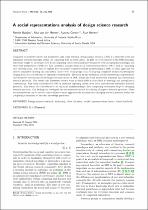JavaScript is disabled for your browser. Some features of this site may not work without it.
- ResearchSpace
- →
- Research Publications/Outputs
- →
- Journal Articles
- →
- View Item
| dc.contributor.author |
Naidoo, R

|
|
| dc.contributor.author |
Van der Merwe, A

|
|
| dc.contributor.author |
Gerber, A

|
|
| dc.contributor.author |
Hevner, A

|
|
| dc.date.accessioned | 2016-07-11T10:57:55Z | |
| dc.date.available | 2016-07-11T10:57:55Z | |
| dc.date.issued | 2015-07 | |
| dc.identifier.citation | Naidoo, R, Van der Merwe, A, Gerber, A and Hevner A. 2015. A social representations analysis of design science research. South African Computer Journal, Vol 56, pp. 33-49 | en_US |
| dc.identifier.issn | 1015-7999 | |
| dc.identifier.uri | http://sacj.cs.uct.ac.za/index.php/sacj/article/view/274 | |
| dc.identifier.uri | http://hdl.handle.net/10204/8627 | |
| dc.description | Copyright: 2015 SACJ. | en_US |
| dc.description.abstract | Compared to positivist survey and interpretive case study research, design science research (DSR) is a relatively novel and unfamiliar research paradigm within the computing field in South Africa. In light of recent interest in the DSR paradigm, this study sought to investigate how local computing researchers familiarise themselves with an unfamiliar paradigm and what their perspectives of DSR are. Key theoretical concepts from social representations theory (SRT), such as 'anchoring' and 'objectification', were used to explore how researchers constructed their understanding of DSR. A visual approach was used to administer drawing and association tasks to two focus groups; each focus group comprised around 25 participants ranging from doctoral students to experienced researchers. The focus group discussions invoked interesting complementary and distinctive associations about the process and content of DSR, specifically when anchored in dominant and conventional research practices. The results also illustrated several ways in which DSR is objectified in drawings and metaphorical constructions. This study concludes that SRT is useful for exploring beliefs about novel and relatively unfamiliar research practices. This study also contributes to an enhanced understanding of how computing researchers adapt to changing research practices. The findings are developed into recommendations for introducing changes to research practices. These recommendations can be used to direct efforts to more appropriately accommodate changing research practices within the computing community to broaden knowledge generation. | en_US |
| dc.language.iso | en | en_US |
| dc.publisher | SACJ | en_US |
| dc.relation.ispartofseries | Workflow;16027 | |
| dc.subject | Design science research | en_US |
| dc.subject | Anchoring | en_US |
| dc.subject | Objectification | en_US |
| dc.subject | Social representations theories | en_US |
| dc.subject | Visual methods | en_US |
| dc.title | A social representations analysis of design science research | en_US |
| dc.type | Article | en_US |
| dc.identifier.apacitation | Naidoo, R., Van der Merwe, A., Gerber, A., & Hevner, A. (2015). A social representations analysis of design science research. http://hdl.handle.net/10204/8627 | en_ZA |
| dc.identifier.chicagocitation | Naidoo, R, A Van der Merwe, A Gerber, and A Hevner "A social representations analysis of design science research." (2015) http://hdl.handle.net/10204/8627 | en_ZA |
| dc.identifier.vancouvercitation | Naidoo R, Van der Merwe A, Gerber A, Hevner A. A social representations analysis of design science research. 2015; http://hdl.handle.net/10204/8627. | en_ZA |
| dc.identifier.ris | TY - Article AU - Naidoo, R AU - Van der Merwe, A AU - Gerber, A AU - Hevner, A AB - Compared to positivist survey and interpretive case study research, design science research (DSR) is a relatively novel and unfamiliar research paradigm within the computing field in South Africa. In light of recent interest in the DSR paradigm, this study sought to investigate how local computing researchers familiarise themselves with an unfamiliar paradigm and what their perspectives of DSR are. Key theoretical concepts from social representations theory (SRT), such as 'anchoring' and 'objectification', were used to explore how researchers constructed their understanding of DSR. A visual approach was used to administer drawing and association tasks to two focus groups; each focus group comprised around 25 participants ranging from doctoral students to experienced researchers. The focus group discussions invoked interesting complementary and distinctive associations about the process and content of DSR, specifically when anchored in dominant and conventional research practices. The results also illustrated several ways in which DSR is objectified in drawings and metaphorical constructions. This study concludes that SRT is useful for exploring beliefs about novel and relatively unfamiliar research practices. This study also contributes to an enhanced understanding of how computing researchers adapt to changing research practices. The findings are developed into recommendations for introducing changes to research practices. These recommendations can be used to direct efforts to more appropriately accommodate changing research practices within the computing community to broaden knowledge generation. DA - 2015-07 DB - ResearchSpace DP - CSIR KW - Design science research KW - Anchoring KW - Objectification KW - Social representations theories KW - Visual methods LK - https://researchspace.csir.co.za PY - 2015 SM - 1015-7999 T1 - A social representations analysis of design science research TI - A social representations analysis of design science research UR - http://hdl.handle.net/10204/8627 ER - | en_ZA |






